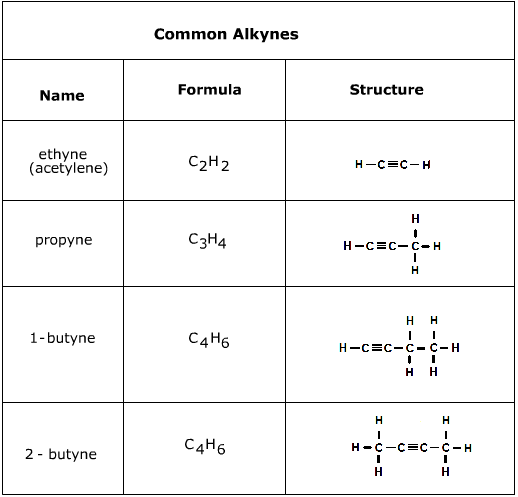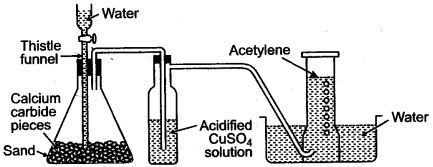Alkynes (Acetylenes):naming, preparation,properties
Alkynes (Acetylenes)
- Unsaturated hydrocarbon
- have one or more triple bond between carbon atom
- The general formula:CnH2n-2
- one sigma bond hard to be broken
- 2 Pi bonds easy to be broken so they are very active
- The first member is ethyne C2H2
- Its common name is acetylene

Here are the molecular formulas and names of the first ten carbon straight chain alkynes.
- Ethyne C2H2
- propyne C3H4
- 1-Butyne C4H6
- 1-Pentyne C5H8
- 1-Hexyne C6H10
- 1-Heptyne C7H12
- 1-Octyne C8H14
- 1-Nonyne C9H16
- 1-Decyne C10H18
Nomenclature of Alkynes
- The name of alkyne is derived from the name of corresponding alkane by replacing the suffix (ane) by suffix (yne).
- Find the longest carbon chain that includes both carbons of the triple bond.
- Numbering the carbon chain starts from the end which is nearest to the triple bond whatever the position of any other branched group.
- * The name of alkyne is proceeding by the number of carbon atom which is attached to the triple bond

Preparation of alkyne in lab.:
Actylene is prepared by dropping water on calcium carbide (calcium dicarbide).

CaC2 +2HOH ⇒ C2H2 +Ca(OH)2
– Give Reason:Actylene gas must be firstly passes over copper sulphate solution in dilsuphuric acid?
-To remove phosophine gas(PH3) and hydrogen sulphide H2S that is due to impurities of CaC2
Burning of Ethyne:
Burning of Ethyne in limited oxygen
Ethyne burns with a smoky flame in a limited amount of air because carbon does not completely burn.
2C2H2 +3O2 ⇒ 2CO2 +2H2O+2C
Burning of Ethyne in excess amount of oxygen
Burns producing CO2 ,water vapor and heat energy (exothermic reaction)
2C2H2 +4O2 ⇒ 4CO2 +2H2O +heat
The amount of heat reaches about 3000? C, therefore oxyacetylene flame is used for welding and cutting metals.
Chemical properties of ethyne:
Because ethyne contain two (Pi) bonds beside one sigma bond, it reacts by addition in two steps. The triple bond is changed to double and then to single bond. The addition reactions can be illustrated as follow.
a- Hydrogenation of ethyne
In the presence of finely divided nickel in 2 steps

b- Halogenation of ethyne
Ethyne reacts vigorously with halogens. The reaction may be accompanied by flame and light when it reacts with chlorine.
However, when ethyne is passed through bromine water dissolved in carbon tetrachloride, the red colour of bromine is discharged.
This reaction is used to detect the unsaturation of ethyne.
C2H2+Br2 → C2H2Br2 +Br2 → C2H2Br4
c-The addition of halogen acids (HX)
bromine dissolved in carbon tetrachloride

d-Addition of water (catalytic hydration)
-Ethyne reacts with water by addition in the presence of a catalyst e.g. H2SO4, HgSO4 at 60? C to give acetaldehyde (ethanal).

This reaction is used to prepare ethanoic acid (acetic acid) by the oxidation of acetaldehyde (ethanal).
Oxidation of ethanol to ethanoic acid
CH3-CHO(L)+{O}-acidifiedKMnO4→CH3COOH (L)
Ethanal(Acetaldehyde ethanoic acid(acetic acid)
Reduction of aldehydes
CH3CHO 2H reduction → CH3CH2 OH
By heating the natural gas at high temperature (1500 c) then fast cooling (rapid quenching) the product
2CH4(g) 1500c /rapid quenching→ C2H2 +3H2(g)
Draw the apparatus used in preparation of an unsaturated organic gas in which there are 2 pi bonds and one sigma bond between its two carbon atom ?
Notes:
Methane reacts with chlorine in presence of ultraviolet rays (substitution reaction) and doesn’t react with bromine water
Ethene and ethyne react with bromine water (addition reaction)
Give reason: Bromine dissolved in carbon tetrachloride can not be used to differentiate between ethene and ethyne ?
-Because it reacts with both of them by addition leads to the disappearance of the red color of bromine
Leave a Reply
You must be logged in to post a comment.

This piece has the kind of depth that makes it impossible to rush through. I found myself lingering over each sentence, appreciating not just the content but the care with which it was crafted. It’s the kind of writing that stays with you, makes you think, and makes you feel all at once.
Your words don’t just speak to the mind; they reach deep into the soul, evoking a response that lingers long after reading.
There’s a certain magic in the way you make even the most abstract ideas feel personal and real.
There’s something mesmerizing in the way you bring clarity to complex concepts, making them feel like second nature.
There’s a quiet strength in your words that makes them linger long after reading.